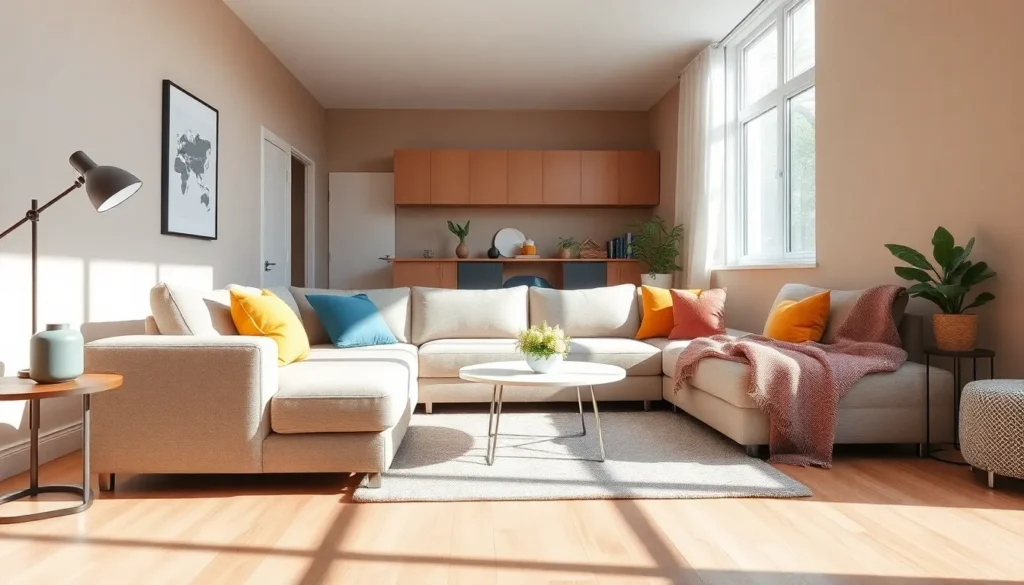In a world where clutter reigns supreme and every corner seems to be a potential disaster zone, home space planning is the superhero we didn’t know we needed. Imagine transforming your chaotic living room into a serene sanctuary where even your cat can finally find peace. It’s not just about fitting furniture; it’s about creating a flow that makes your home feel inviting and functional.
Table of Contents
ToggleWhat Is Home Space Planning?
Home space planning involves organizing areas within a residence to enhance functionality and aesthetics. Professionals in interior design apply principles of space planning to create effective layouts that maximize usable areas. This approach considers elements like furniture arrangement, traffic flow, and the natural lighting of a space.
Identifying key areas within a home is vital. Living rooms, kitchens, and bedrooms each have unique requirements and purposes. Assessing the specific needs of these spaces leads to tailored solutions that facilitate better use and comfort.
The process includes measuring dimensions accurately before making decisions. Understanding the size of rooms provides critical insights for selecting appropriate furnishings and décor. Larger items may require ample space, while smaller pieces can create a cozy atmosphere without overwhelming the environment.
Integrating storage solutions forms a major part of space planning. Utilizing built-in shelves, multi-functional furniture, and hidden compartments promotes organization and reduces clutter. Effective storage not only enhances functionality but also contributes to a more serene visual environment.
A key aspect of home space planning is creating flow throughout the home. Establishing a logical layout encourages ease of movement and enhances the overall ambiance. Smooth transitions between areas foster a welcoming atmosphere, making the home feel cohesive and inviting.
Home space planning encourages creativity in design. It offers opportunities to experiment with color schemes, furniture styles, and decorative elements. Adapting spaces to reflect personal tastes while maintaining practicality results in more satisfying living environments that cater to individual lifestyles.
Importance Of Home Space Planning

Home space planning significantly impacts living environments. By organizing spaces effectively, homeowners create functional and appealing areas.
Enhancing Functionality
Enhancing functionality stands as a primary goal of home space planning. Effective layouts accommodate the needs of various activities, ensuring each space serves its intended purpose. For instance, a well-planned kitchen supports cooking and socializing while providing ample storage. Accurate measurements help select furnishings that fit perfectly, preventing overcrowding. Thoughtfully designed spaces also promote ease of movement, allowing seamless transitions from one area to another. This efficient use of space transforms cluttered residences into organized sanctuaries.
Improving Aesthetics
Improving aesthetics plays a crucial role in home space planning. Coordinating colors, textures, and styles helps create visually appealing environments. Furniture placement influences how light flows through spaces, enhancing the overall atmosphere. Beautiful decor can make areas feel more inviting for guests and family alike. Integrating personal design preferences fosters a unique character within each room, reflecting individual lifestyles. By striking a balance between functionality and beauty, space planning results in harmonious living spaces.
Key Principles Of Home Space Planning
Effective home space planning transforms environments into functional and aesthetically pleasing areas. Focus lies on understanding needs, creating flow, and maximizing natural light.
Assessing Your Needs
Evaluating personal requirements forms the foundation of successful space planning. Identify priorities for each room based on lifestyle and activities. Consider the amount of furniture necessary for comfort and functionality. Measure dimensions accurately to accommodate specific items. Analyze traffic patterns and frequently used areas to determine accessibility. Prioritizing needs ensures that space serves its intended purpose while promoting organization.
Creating Flow
Establishing a logical flow enhances movement throughout the home. Arrange furniture to encourage easy navigation and interaction. Define open pathways between rooms, allowing for seamless transitions. Group similar functions together, such as placing the dining area near the kitchen. Incorporate visual cues through colors and textures to guide the eye. Effective flow cultivates an inviting atmosphere that enhances the overall experience of the home.
Maximizing Natural Light
Utilizing natural light enhances both form and function within a space. Position furniture to avoid blocking windows and allow sunlight to filter in. Use light-colored paint and reflective surfaces to amplify brightness. Incorporate strategically placed mirrors to create the illusion of more depth and space. Select window treatments that permit flexibility in light control while maintaining privacy. Prioritizing natural light results in a vibrant, uplifting environment that promotes well-being.
Common Mistakes In Home Space Planning
Effective home space planning can be undermined by several common mistakes that hinder functionality and aesthetic appeal. Identifying these pitfalls contributes to more successful layouts.
Overcrowding Spaces
Overcrowding spaces leads to discomfort and chaos. When furniture and decor overwhelm an area, it disrupts movement and accessibility. Selecting essential pieces instead of cluttering the room promotes a more inviting atmosphere. Maintaining open pathways enhances flow and encourages interaction. Prioritizing essential items allows for a more spacious feeling, making it easier to navigate and enjoy the space.
Ignoring Scale And Proportion
Ignoring scale and proportion can result in awkward and unbalanced spaces. Furniture that is too large or too small can distort a room’s appearance and functionality. Ideal furnishings complement each other in size, creating harmony within the environment. Choosing appropriately scaled pieces ensures that each area feels balanced and practical. Evaluating room dimensions before purchasing items allows for better fitting choices that enhance overall design.
Tips For Effective Home Space Planning
Effective home space planning transforms living environments into organized, functional areas. Achieving the right balance among various elements fosters comfort and aesthetic appeal.
Utilizing Furniture Wisely
Selecting the right furniture makes a significant impact. Prioritize functionality over size to ensure a comfortable layout. Avoid overcrowding by opting for multifunctional furniture, such as a sofa bed or a coffee table with storage. Consider arrangements that promote conversation and easy movement throughout the room. Position larger pieces against walls to create an open feeling in the center. Choosing lightweight chairs and tables can facilitate rearrangement, allowing for adaptability based on activities. Assessing room dimensions ensures that furniture fits appropriately, maintaining balance and harmony within the space.
Incorporating Storage Solutions
Effective storage solutions optimize space and reduce clutter. Integrated shelving units work well in living rooms and kitchens, providing visibility and accessibility for items. Using under-the-bed storage boxes offers hidden space for seasonal clothes or extra linens. Consider vertical storage options like tall bookcases or hanging shelves to maximize height. Utilizing cabinetry in kitchens adds both functionality and style while neatly concealing kitchenware. Incorporating hooks or pegboards in entryways keeps frequently used items readily available. Prioritizing organization through these solutions creates a more serene environment, enhancing the overall living experience.
Effective home space planning can significantly enhance both functionality and aesthetics. By embracing thoughtful organization and strategic furniture placement, individuals can transform their living environments into serene and inviting spaces. Prioritizing personal needs while maximizing natural light creates a harmonious flow that encourages ease of movement.
Avoiding common pitfalls such as overcrowding and neglecting scale ensures that each area serves its intended purpose without sacrificing style. With the right approach, homeowners can enjoy beautifully organized spaces that reflect their unique lifestyles. Ultimately, investing time in space planning leads to a more enjoyable and functional home.




